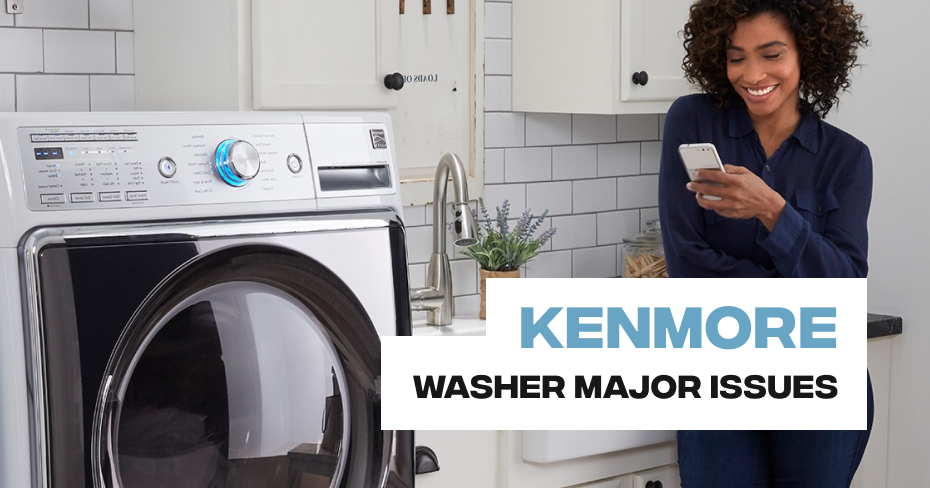
Kenmore Washer Leaks
Kenmore Washing Machine Drain Pump
The drain pump pumps water out the drain hose. If the drain pump is cracked or damaged, or if the bearings are worn out, the drain pump may leak water. The drain pump is not repairable—if the pump is leaking water, replace it.
Kenmore Washing Machine Hose
Hoses apart from the fill hose or drain hose could be reponsible for a leaking washer. You should inspect all of the appliance’s hoses, such as tub-to-pump hoses, for damage or loose connections and replace if necessary.
Kenmore Washing Machine Tub Seal and Bearing Kit
The tub seal might be torn, causing water to leak from the seal. If the tub seal is leaking water, water may leak through the tub seal and into the tub bearings. This can cause the bearings to fail. For this reason, if the tub seal is leaking water, replace both the tub seal and the tub bearings. Be aware that this is a complicated repair and will require disassembling most of the washer.
Kenmore Washing Machine Tub Seal
The tub seal might be torn, causing water to leak from the seal. If the tub seal is leaking water, water may leak through the tub seal and into the tub bearings. This can cause the bearings to fail. For this reason, if the tub seal is leaking water, replace both the tub seal and the tub bearings. Be aware that this is a complicated repair and will require disassembling most of the washer.
Kenmore Washing Machine Dispenser Drawer
If a washer is leaking water, you should confirm the dispenser drawer is completely closed and free of damage. If the drawer is cracked, the component could be responsible for the leak and should be replaced.
Wrong type or incorrect amount of detergent
If you have a front-load washer, be certain that you are using an HE – high efficiency – detergent. HE detergent is formulated to be low-sudding and to be used with the lower water levels utilized by front-load washers. Front-load washers have a small overflow system usually on the back of the appliance. If you have too many suds, they are probably escaping from there.
Kenmore Washing Machine Transmission
Since the transmission shaft extends into a top-load washer’s inner tub, a transmission bearing or tub seal that is damaged could potentially cause the tub to leak near the motor area. For some models, these components may only be sold as an assembly, you may need to replace the entire transmission assembly to solve the leaking problem.
Kenmore Washing Machine Door Boot Seal
The door boot seal might be torn, causing water to leak from the seal. If the boot seal is torn, replace it.
Kenmore Washing Machine Tub-to-Pump Hose
The tub-to-pump-hose might be split or torn. If the tub-to-pump-hose is damaged, replace it. Do not attempt to cut off the damaged piece of hose and stretch the hose to fit the pump. Stretching the hose will put strain on the remainder of the hose and may cause the hose to suddenly rupture.
Kenmore Washing Machine Boot Seal Retaining Ring
The boot seal retaining ring is the component used to secure the door boot seal on front-load washing machines. If the retaining ring is broken or missing, the boot seal can become dislodged and allow water to leak out through the closed door during operation. Inspect the boot seal retaining ring for damage and replace if necessary.
Kenmore Washing Machine Water Inlet Valve
A washing machine water inlet valve allows water to fill the tub prior to the agitation and rinse cycles. If water is leaking out of the washer during a fill cycle, it’s likely the water inlet valve or a hose connected to it is damaged. Inspect the valve housing for any cracks and the attached hoses for holes or tears and replace if necessary.
Kenmore Washing Machine Drain Hose
The drain hose may be leaking. The drain hose most commonly leaks from the connection between the pump and the back of the washer. If the washer is pushed too far against the wall, the hose can rub against the wall and form a leak. Inspect the drain hose for leaks. If the drain hose is leaking, replace it.
Kenmore Washing Machine Fill Hose
Inspect the hot and cold fill hoses to confirm the the hoses are securely fastened to both the home’s water supply valves and the washing machine’s water inlet valve intake ports. You should also confirm the hoses have no holes or tears. It is recommended that the fill hoses be replaced every five years regardless of condition.
